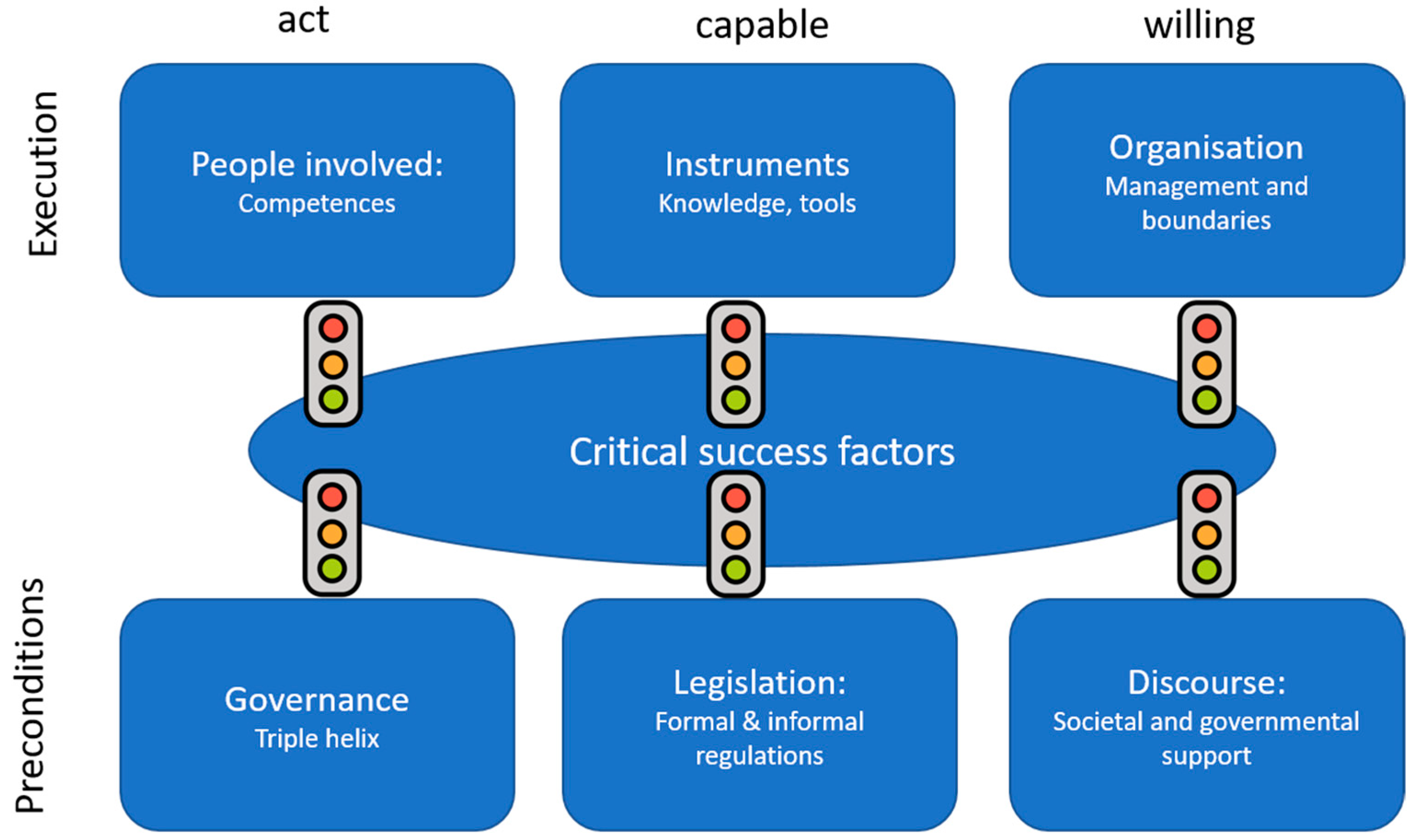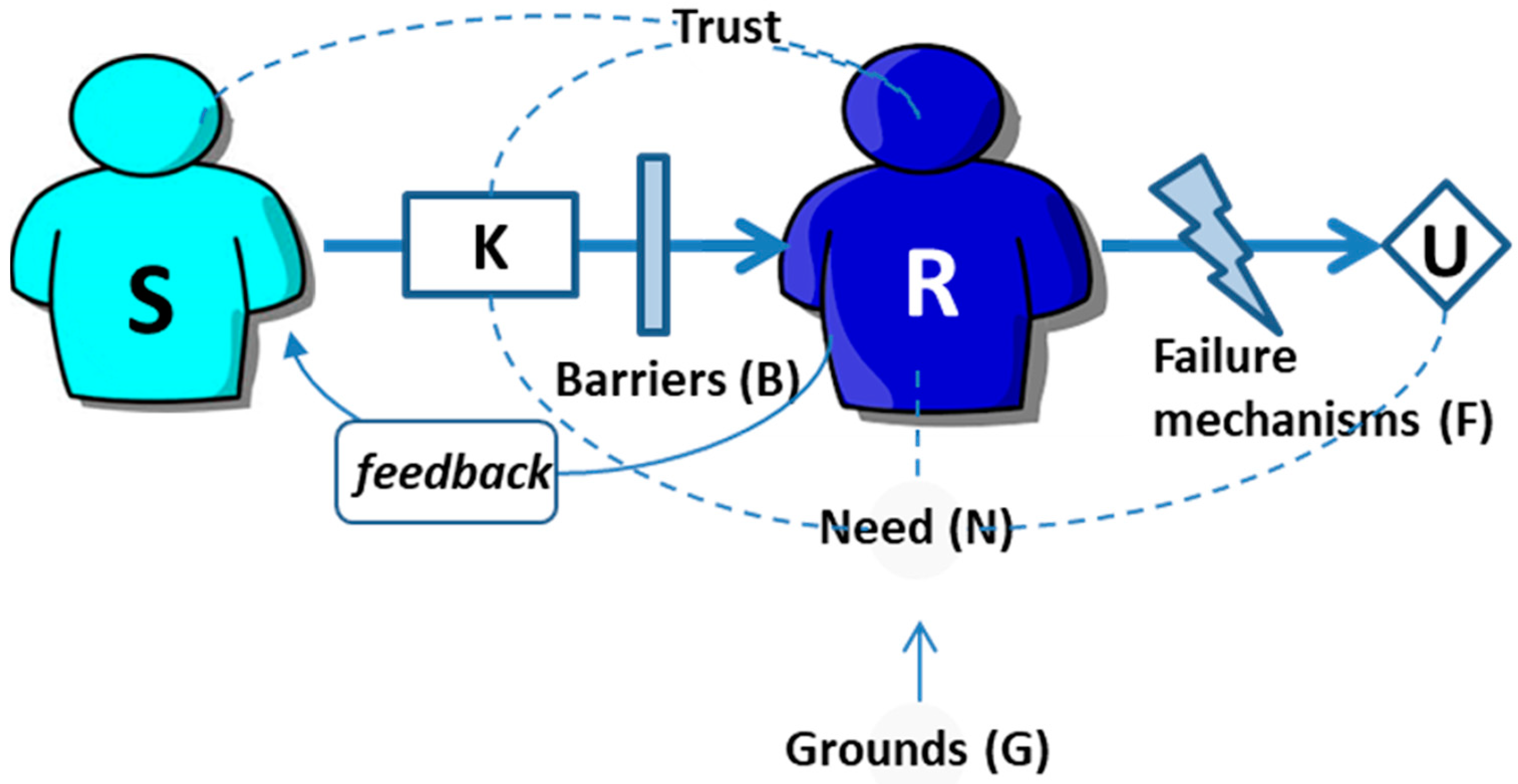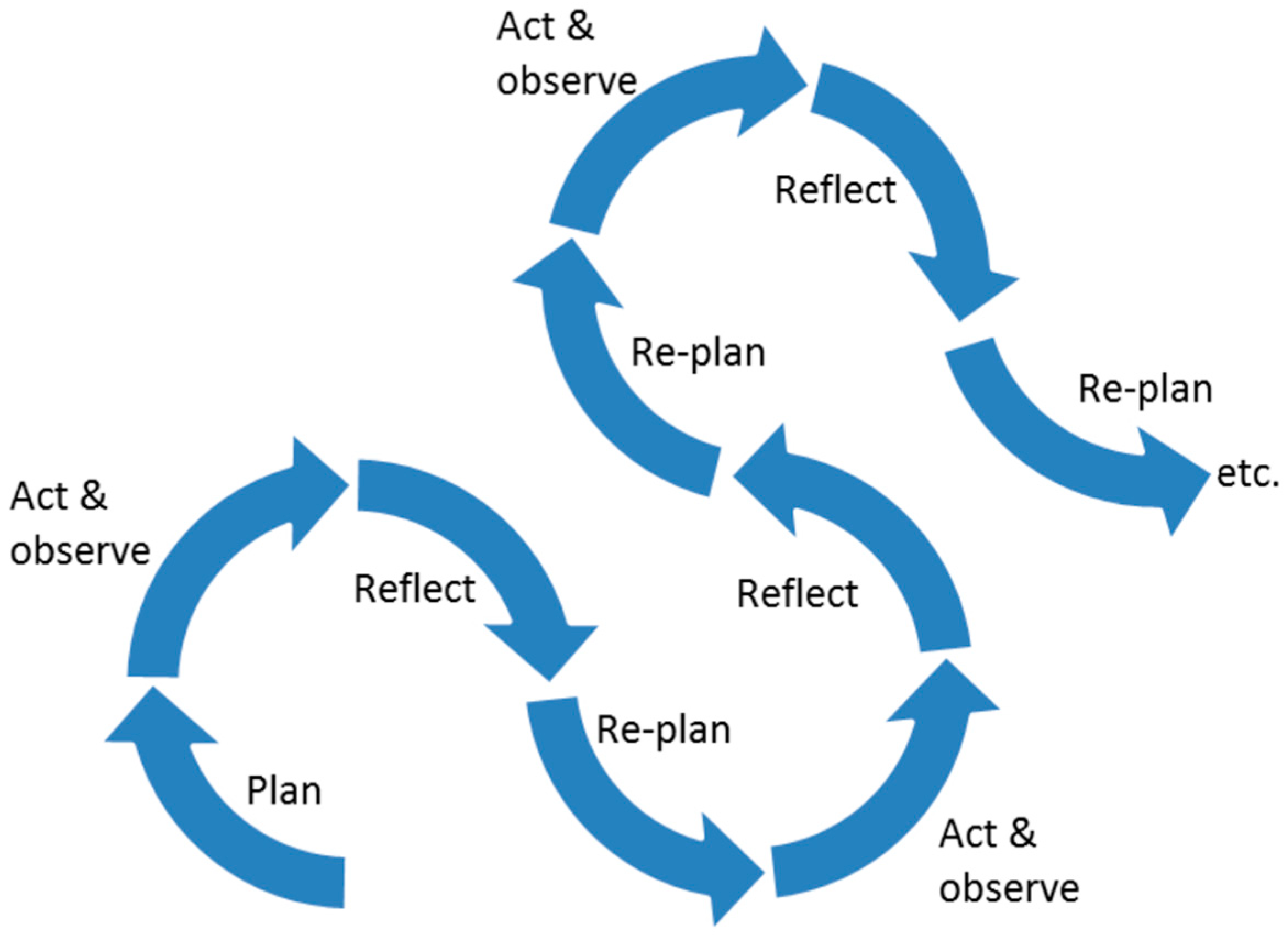The Dutch Flood Protection Programme: Taking Innovations to the Next Level
Abstract
:1. Introduction
- Increase the production rate (effectiveness) of flood defence projects;In programmes in the past, approximately 25 km was upgraded annually. In order to complete the objective of around 1500 km by 2050, this rate will have to rise to an average of ~50 km/year [2].
- Improve efficiency by reducing the costs per kilometre;In recent decades, the average cost per kilometre in the Netherlands has increased to more than €10 million (in the 2nd Dutch Flood Protection Programme), and in the early years of the DFPP, the average cost rose towards €18 million per kilometre. Given the annual budget of € 360 million, this figure will have to be reduced again to ~€7 million per kilometre [3].
2. Materials and Methods
2.1. Dutch Flood Protection Programme: Context
- People involved: is sufficient knowledge and expertise available for the project team, and does the involved people have the required competences?
- Instruments: are the knowledge and tools available to design the flood defences in its surroundings?
- Organisation: is there political willingness to take risks, and what boundary conditions have been given to the project team? The officials of the regional water authorities are closely involved in the DFPP, through recurring meetings and their role as ambassadors of innovations, which helps in the formulation of the instructions to, and steering of, the project teams.
- Governance: how is decision-making organised, and how are organisations such as contractors and local stakeholders involved?
- Legislation: how can the project comply with formal and informal regulations?
- Discourse: is there sufficient support in society for strengthening the flood defences?
2.2. Methods
2.3. Data Collection
- Which knowledge and innovations do you know or have you heard of?
- Which innovations are being considered in your project?
- Which innovations are being developed within your project?
- Which new knowledge and innovations are/will be applied in your project?
- What are the main reasons for considering or applying all the knowledge and innovations you mentioned in your project?
3. Results
3.1. Knowledge and Innovation Strategy
- Action research cycle: Analysis of four technical research and test projects
- 2.
- Action research cycle: Innovation Next Level
- 3.
- Action research cycle: Towards a new Knowledge and Innovation Strategy
- Furthering innovations
- Return on investment at the project and programme levels (balance of the costs and benefits between the project and programme);
- Reproduction factor (level of development in relation to applications in the programme);
- Contribution to alliance (builds on previous projects and seeks cooperation with other water authorities and other knowledge developers).
- 2.
- Encouraging the application of new knowledge and innovations
- 3.
- Knowledge transfer and uptake
- The broker role matches the supply and demand of knowledge. This requires a state-of-the-art overview of existing knowledge and the current knowledge gaps.
- The translator role interprets the knowledge needs of the end users and formulates questions for the knowledge developers. The translator is also capable of translating the knowledge to match the needs of the end users.
- The synthesiser is capable of synchronising knowledge supply and demand. This requires a broad understanding of knowledge disciplines and sources and of how they can contribute to problem-solving.
3.2. Monitoring Knowledge and Innovation
4. Discussion and Conclusions
Author Contributions
Funding
Institutional Review Board Statement
Informed Consent Statement
Data Availability Statement
Acknowledgments
Conflicts of Interest
References
- Most, H.; van der Tánczos, I.; Bruijn, K.M.; de Wagenaar, D. New Risk-based standards for flood protection in the Netherlands. In Proceedings of the 6th International Conference on Flood Management, Sao Paulo, Brazil, 16–18 September 2014. [Google Scholar]
- Jorissen, R.; Kraaij, E.; Tromp, E. Dutch flood protection policy and measures based on risk assessment. In Proceedings of the 3rd European Conference on Flood Risk Management (FLOODrisk 2016), Lyon, France, 17–21 October 2016. [Google Scholar] [CrossRef] [Green Version]
- DFPP. 1st Knowledge and Innovation Strategy (Kennis en Innovatiestrategie HWBP); Report; DFPP: Copenhagen, The Netherlands, December 2012. (In Dutch) [Google Scholar]
- Ackoff, R.L. The future of operational research is past. J. Oper. Res. Soc. 1979, 30, 93–104. [Google Scholar] [CrossRef]
- Rittel, H.W.; Webber, M.M. Dilemmas in a general theory of planning. Policy Sci. 1973, 4, 155–169. [Google Scholar] [CrossRef]
- Tromp, E. Enhancing Knowledge Transfer and Uptake in the Design Processes of Flood Defences. Ph.D. Thesis, Delft University of Technology, Delft, The Netherlands, 11 November 2019. [Google Scholar]
- Bloemen, P.J.T.M.; Hammer, F.; van der Vlist, M.J.; Grinwis, P.; van Alphen, J. DMDU into Practice: Adaptive Delta Management in The Netherlands. In Decision Making under Deep Uncertainty: From Theory to Practice, 1st ed.; Marchau, V.A.W.J., Walker, W.E., Bloemen, P.T.J.M., Popper, S.W., Eds.; Springer: Cham, Switzerland, 2019; pp. 321–355. [Google Scholar]
- Taskforce Ten Heuvelhof. Een Dijk Van een Programma, Naar Een Nieuwe Aanpak Van Het Hoogwaterbeschermingsprogramma; Report; Ministerie van Verkeer en Waterstaat: Copenhagen, The Netherlands, 16 December 2010. (In Dutch) [Google Scholar]
- DFPP. Knowledge and Innovation Agenda (Kennis en Innovatieagenda HWBP); Report; DFPP: Copenhagen, The Netherlands, November 2019. (In Dutch) [Google Scholar]
- Van Buuren, M.W.; Edelenbos, J. Kennis en kunde voor participatie. In Jaarboek Kennissamenleving ‘Burger in Uitvoering’; University Press: Amsterdam, The Netherlands, 2008; Chapter 10. [Google Scholar]
- Van Herk, S. Delivering Integrated Flood Risk Management; Governance of Collaboration, Learning and Adaptation. Ph.D. Thesis, Delft University of Technology, Delft, The Netherlands, 14 February 2014. [Google Scholar]
- Tidd, J.; Bissant, J.R. Managing Innovations: Integrating Technological, Market and Organizational Change; John Wiley & Sons: West Sussex, UK, 2013. [Google Scholar]
- Cooper, R. Perspective: The Stage-Gate® Idea-to-Launch Process—Update, What’s New, and NexGen Systems. J. Prod. Innov. Manag. 2008, 25, 213–232. [Google Scholar] [CrossRef]
- Knoeff, J.G.; Van Der Meer, M.; Van Nieuwenhuizen, L.; Tromp, E.; Woning, M.; Leeuwdrent, W.; Bizzarri, A. Guidance on Innovations in Flood Defences Green Version (Handreiking Innovaties Waterkeringen, Groene Versie); Hoogwaterbeschermingsprogramma Report; Rijkswaterstaat: Copenhagen, The Netherlands, May 2013. (In Dutch) [Google Scholar]
- Tromp, E.; Knoeff, J.G.; Tanis, H.; Heijn, K.; Leung, N. Guidance on Innovations in Flood Defences (Handreiking Innovaties Waterkeringen); Hoogwaterbeschermingsprogramma Report; Rijkswaterstaat: Copenhagen, The Netherlands, 1 November 2016. (In Dutch) [Google Scholar]
- Shrivastava, P.; Mitroff, I.I.; Miller, D.; Miglani, A. Understanding industrial crises. J. Manag. Stud. 1988, 25, 283–303. [Google Scholar] [CrossRef]
- Van Staveren, M. Uncertainty and Ground Conditions, A Risk Management Approach, 1st ed.; Butterworth-Heinemann Elsevier Ltd.: Oxford, UK, 2006. [Google Scholar]
- DFPP. Assessment of Opportunities (Kansenscan); Report; DFPP: Copenhagen, The Netherlands, 2013. (In Dutch) [Google Scholar]
- Vlachos, E. A conceptual model of the knowledge transfer process. In Proceedings of the Second International Conference on Water Resources Knowledge, Fort Collins, CO, USA, 29 June 1977. [Google Scholar]
- Knott, J.; Wildavsky, A. If dissemination is the solution, what is the problem? Knowl. Creat. Diffus. Util. 1980, 4, 537–578. [Google Scholar] [CrossRef]
- McKay, J.; Marshall, P. The dual imperatives of action research. Inf. Technol. People 2001, 14, 46–59. [Google Scholar] [CrossRef] [Green Version]
- Kemmis, S. Exploring the relevance of critical theory for action research: Emancipatory action research in the footsteps of Jurgen Habermas. In Handbook of Action Research: Participative Inquiry and Practice; Reason, P., Bradbury, H., Eds.; Sage: London, UK, 2001; pp. 91–102. [Google Scholar]
- Carr, W.; Kemmis, S. Becoming Critical: Education, Knowledge and Action Research; RoutledgeFalmer: London, UK, 1986. [Google Scholar]
- Kemmis, S.; Taggart, R. Participatory action research. Communicative action and the public sphere. In Handbook of Qualitative Research; Denzin, N.K., Lincoln, Y.S., Eds.; Sage: Thousand Oaks, CA, USA, 2005. [Google Scholar]
- Duijn, M.; Vreugdenhil, H.; Janssen, S.; Tromp, E.; Ellen, G.J. Organising knowledge generation and dissemination in the Dutch high-water protection programme—A sender-receiver approach. Knowl. Manag. Res. Pract. 2021. [Google Scholar] [CrossRef]
- DFPP. Innovation Next Level (Innovatie Next Level); Report; DFPP: Copenhagen, The Netherlands, 2016. (In Dutch) [Google Scholar]
- DFPP. Update Knowledge and Innovation Approach-Executive Level (Process); Report; DFPP: Copenhagen, The Netherlands, 2018. (In Dutch) [Google Scholar]
- Twynstra Gudde. Evaluatie POV’s, Een Overzicht van Geleerde Lessen; Report; DFPP: Copenhagen, The Netherlands, 17 December 2019. (In Dutch) [Google Scholar]
- DFPP. Dashboard v0.1 Monitoring of Innovations 2018 (Dashboard Monitoring van Innovaties 2018); Report; DFPP: Copenhagen, The Netherlands, January 2018. (In Dutch) [Google Scholar]
- DFPP. Dashboard v0.1 Monitoring of Innovations 2019, (Dashboard Monitoring van Innovaties 2019); Report; DFPP: Copenhagen, The Netherlands, 23 January 2019. (In Dutch) [Google Scholar]
- Panteia. Monitor HWBP Kennis en Innovatie—Report Panteia Zoetermeer; DFPP: Copenhagen, The Netherlands, 4 February 2022. (In Dutch) [Google Scholar]
- Van Meerkerk, I.; Edelenbos, J. Boundary Spanners in Public Management and Governance: An Interdisciplinary Assessment; Edward Elgar Publishing: Cheltenham, UK, 2018. [Google Scholar]
- Konstadinou, M.; Zwanenburg, C. A critical review of membrane and filter paper correction formulas for the triaxial testing of soft soils. Geotech. Test. J. 2019, 43, 19. [Google Scholar] [CrossRef]
- Taccari, M.L.; Zwanenburg, C. Large scale triaxial compression tests on three peat samples from Eemdijk, The Netherlands. In Proceedings of the XVII ECSMGE-2019, Reykjavik, Iceland, 1–6 September 2019; ISBN 978-9935-9436-1-3. [Google Scholar] [CrossRef]
- Breedeveld, J.; Zwanenburg, C.; Van, M.; Langkeek, H.J. Impact of the Eemdijk full-scale test programme. In Proceedings of the XVII ECSMGE-2019, Reykjavik, Iceland, 1–6 September 2019. [Google Scholar] [CrossRef]
- Van der Krogt, M.G.; Schweckendiek, T.; Kok, M. Do all dike instabilities cause flooding? In Proceedings of the 13th International Conference on Applications of Statistics and Probability in Civil Engineering (ICASP13), Seoul, Korea, 26–30 May 2019. [Google Scholar] [CrossRef]
- Van der Krogt, M.G.; Klerk, W.J.; Kanning, W.; Schweckendiek, T.; Kok, M. Value of Information of combinations of proof loading and pore pressure monitoring for flood defences. J. Struct. Infrastruct. Eng. 2022, 18, 505–520. [Google Scholar] [CrossRef]
- Van Beek, V.M.; Van Essen, H.M.; Vandenboer, K.; Bezuijen, A. Developments in modelling of backward erosion piping. Géotechnique 2015, 65, 740–754. [Google Scholar] [CrossRef] [Green Version]
- Robbins, B.A.; Van Beek, V.M.; López-Soto, J.F.; Montalvo-Bartolomei, A.M.; Murphy, J. A novel laboratory test for backward erosion piping. Int. J. Phys. Model. Geotech. 2018, 18, 266–279. [Google Scholar] [CrossRef]
- Van Steeg, P.; Klein Breteler, M.; Provoost, Y. Large-scale physical model tests to determine influence factor of roughness for wave run-up of channel shaped block revetments. In Proceedings of the 6th International Conference on the Application of Physical Modelling in Coastal and Port Engineering and Science (Coastlab 2016), Ottawa, ON, Canada, 10–13 May 2016. [Google Scholar]
- Klein Breteler, M.; Provoost, Y.; Van Steeg, P.; Wolters, G.; Kaste, D.; Mourik, G. Stability Comparison of 9 Modern Placed Block Revetment types for Slope Protections. J. Coast. Eng. 2018, 36, 75. [Google Scholar] [CrossRef] [Green Version]
- Rosenbrand, E.; Van Beek, V.M.; Bezuijen Akrami, S.; Terwindt, J.; Koelewijn, A.; Förster, U. Multi-scale experiments for a coarse sand barrier against backward erosion piping. Géotechnique 2022, 72, 216–226. [Google Scholar] [CrossRef]
- Rosenbrand, E.; Van Beek, V.M.; Bezuijen, A. Numerical Modelling of the resistance of the coarse sand barrier against backward erosion piping. Géotechnique 2021, 1–10, ahead to print. [Google Scholar] [CrossRef]
- Waterschap Vechtstromen, De Vecht, een Grenzeloze, Halfnatuurlijke Rivier, Grensoverschrijdende Vechtvisie, Report (In Dutch Only). Available online: https://devecht.eu/publish/pages/29934/nl_vechtvisie_internet_1.pdf (accessed on 24 January 2022).
- Hoogheemraadschap Schieland en de Krimpenerwaard, Guidance document Foreland (Handreiking Voorland), Report (Dutch Only). 2019. Available online: https://povvoorlanden.nl/wp-content/uploads/2019/03/Voorland_lowres_spreads_KL02.pdf (accessed on 24 January 2022).
- DFPP. Programmatic Approach to Support Sustainability and Spatial Quality Dutch Flood Protection Programme, Report, Dutch Only. Available online: https://www.hwbp.nl/binaries/hoogwaterbeschermingsprogramma/documenten/rapporten/2020/03/24/programmatische-aanpak-duurzaamheid/Programmatische+aanpak+Duurzaamheid+en+Ruimtelijke+kwaliteit.pdf (accessed on 24 January 2022).
- Faivre, N.; Fritz, M.; Freitas, T.; de Boissezon, B.; Vandewoestijne, S. Nature-Based Solutions in the EU: Innovating with nature to address social, economic and environmental challenges. Environ. Res. 2017, 159, 509–518. [Google Scholar] [CrossRef] [PubMed]
- Bouw, M.; Van Eekelen, E. Building with Nature—Creating, Implementing and Upscaling Nature-Based Solutions, 1st ed.; NAi Publishers: Rotterdam, The Netherlands, 2020; ISBN 978-94-6208-582-4. [Google Scholar]
- Vreugdenhil, H.; Frantzeskaki, N.; Taljaard, S.; Ker Rault, P.; Slinger, J. Next step in policy transitions: Diffusion of pilot projects. In Proceedings of the 13th Annual Conference of the International Research Society for Public Management (IRSPM XIII), Copenhagen, Denmark, 6–8 April 2009. [Google Scholar]
- IPCC Climate Change 2021: The Physical Science Basis, the Working Group I contribution to the Sixth Assessment Report. 2021. Available online: https://www.ipcc.ch/report/ar6/wg1/ (accessed on 24 January 2022).
- IPCC. The Ocean and Cryosphere in a Changing Climate. A Special Report of the Intergovernmental Panel on Climate Change. Intergovernmental Panel on Climate Change. 2019. Available online: https://www.ipcc.ch/srocc/chapter/summary-for-policymakers/ (accessed on 24 January 2022).
- Korff, Y.; von Daniell, K.A.; Moellenkamp, S.; Bots, P.W.G.; Bijlsma, R.M. Implementing participatory water management: Recent advances in theory, practice, and evaluation. Ecol. Soc. 2012, 17, 30. [Google Scholar]
- Pahl-Wostl, C.; Tàbara, D.; Bouwen, R.; Craps, M.; Dewulf, A.; Mostert, E.; Ridder, D.; Taillieu, T. Managing change towards adaptive water management through social learning. Ecol. Soc. 2007, 12, 30. [Google Scholar] [CrossRef]
- Edelenbos, J.; van Buuren, A.; van Schie, N. Co-producing knowledge: Joint knowledge production between experts, bureaucrats and stakeholders In Dutch water management projects. Environ. Sci. Policy 2011, 14, 675–684. [Google Scholar] [CrossRef]
- Koppenjan, J.F.M.; Klijn, E.H. Managing Uncertainties in Networks; Routledge: London, UK, 2004. [Google Scholar]
- Easterby-Smith, M.; Lyles, M.A. (Eds.) Handbook of Organizational Learning and Knowledge Management; John Wiley & Sons: West Sussex, UK, 2011. [Google Scholar]
- Vreugdenhil, H.; Rault, P.K. Pilot Projects for evidence-based policy-making: Three pilot projects in the Rhine Basin. Ger. Policy Stud. 2010, 6, 115–151. [Google Scholar]
- Van Buuren, A.; Vreugdenhil, H.; Van Popering-Verkerk, J.; Ellen, G.J.; van Leeuwen, C.; Breman, B. The Pilot Paradox: Exploring tensions between internal and external success factors In Dutch climate adaptation projects. In Innovating Climate Governance: Moving Beyond Experiments; Cambridge University Press: Cambridge, UK, 2018; p. 145. [Google Scholar]







Publisher’s Note: MDPI stays neutral with regard to jurisdictional claims in published maps and institutional affiliations. |
© 2022 by the authors. Licensee MDPI, Basel, Switzerland. This article is an open access article distributed under the terms and conditions of the Creative Commons Attribution (CC BY) license (https://creativecommons.org/licenses/by/4.0/).
Share and Cite
Tromp, E.; te Nijenhuis, A.; Knoeff, H. The Dutch Flood Protection Programme: Taking Innovations to the Next Level. Water 2022, 14, 1460. https://doi.org/10.3390/w14091460
Tromp E, te Nijenhuis A, Knoeff H. The Dutch Flood Protection Programme: Taking Innovations to the Next Level. Water. 2022; 14(9):1460. https://doi.org/10.3390/w14091460
Chicago/Turabian StyleTromp, Ellen, Anouk te Nijenhuis, and Han Knoeff. 2022. "The Dutch Flood Protection Programme: Taking Innovations to the Next Level" Water 14, no. 9: 1460. https://doi.org/10.3390/w14091460
APA StyleTromp, E., te Nijenhuis, A., & Knoeff, H. (2022). The Dutch Flood Protection Programme: Taking Innovations to the Next Level. Water, 14(9), 1460. https://doi.org/10.3390/w14091460





